
Inuit culture
Encyclopedia
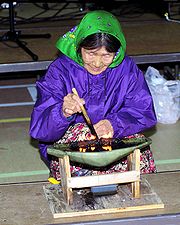
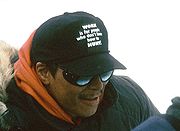
Greenland
Greenland is an autonomous country within the Kingdom of Denmark, located between the Arctic and Atlantic Oceans, east of the Canadian Arctic Archipelago. Though physiographically a part of the continent of North America, Greenland has been politically and culturally associated with Europe for...
. The term culture of the Inuit, therefore, refers primarily to these areas; however, parallels to other Eskimo
Eskimo
Eskimos or Inuit–Yupik peoples are indigenous peoples who have traditionally inhabited the circumpolar region from eastern Siberia , across Alaska , Canada, and Greenland....
groups can also be drawn.
The traditional lifestyle of the Inuit
Inuit
The Inuit are a group of culturally similar indigenous peoples inhabiting the Arctic regions of Canada , Denmark , Russia and the United States . Inuit means “the people” in the Inuktitut language...
is adapted to extreme climactic conditions; their essential skills for survival are hunting and trapping. Agriculture was never possible in the millions of square kilometers of tundra
Tundra
In physical geography, tundra is a biome where the tree growth is hindered by low temperatures and short growing seasons. The term tundra comes through Russian тундра from the Kildin Sami word tūndâr "uplands," "treeless mountain tract." There are three types of tundra: Arctic tundra, alpine...
and icy coasts from Siberia
Siberia
Siberia is an extensive region constituting almost all of Northern Asia. Comprising the central and eastern portion of the Russian Federation, it was part of the Soviet Union from its beginning, as its predecessor states, the Tsardom of Russia and the Russian Empire, conquered it during the 16th...
to Northern America and Greenland. Therefore, hunting became the core of the culture and cultural history of the Inuit of central and east Arctic. Thus, the everyday life in modern Inuit settlements, established only some decades ago, still reflects the five-thousand year long history of a typical hunting culture which allowed the Inuit peoples and their ancestors to achieve one of the most remarkable human accomplishments, the population of the Arctic.
Etymology
Europeans in North America used to refer to the Inuit as Eskimos, but the people consider that term pejorative. The colonists and explorers adopted the term "Eskimo" from the AlgonquinAlgonquin language
Algonquin is either a distinct Algonquian language closely related to the Ojibwe language or a particularly divergent Ojibwe dialect. It is spoken, alongside French and to some extent English, by the Algonquin First Nations of Quebec and Ontario...
-speaking peoples' ethonym for the Inuit, as they encountered the Algonquian peoples first when they landed in the coastal areas. It means either "eaters of raw flesh" or "people who live up the coast." The word Inuit is the autonym, the name which the people use for themselves and it means "the people." Its singular form is Inuk.
Early periods of cultural history
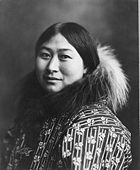
- Western Arctic
- Paleo-Arctic TraditionPaleo-Arctic TraditionThe Paleo-Arctic Tradition is the name given by archaeologists to the cultural tradition of the earliest well-documented human occupants of the North American Arctic, which date from the period 8000–5000 BC...
- Anangula Tradition
- Paleo-Arctic Tradition
Period II (5000-ca. 2000 BCE)
- Western Arctic
- Ocean Bay I
- Northern Archaic tradition
Period III (ca. 2000-1000 BCE)
- Western Arctic
- Takli Culture
- Arctic Small Tool traditionArctic small tool traditionThe Arctic Small Tool tradition is a broad cultural entity that developed along the Alaska Peninsula, round Bristol Bay, and on the eastern shores of the Bering Strait around 2500 BC...
(spreads eastward)
- Eastern Arctic
- Eastern Arctic Small Tool Tradition groups ca. 3000-500 BCE
Overview of cultural history
Archaeologists are certain that the predecessors of today's Inuit originated in the area of the Bering StraitBering Strait
The Bering Strait , known to natives as Imakpik, is a sea strait between Cape Dezhnev, Chukotka Autonomous Okrug, Russia, the easternmost point of the Asian continent and Cape Prince of Wales, Alaska, USA, the westernmost point of the North American continent, with latitude of about 65°40'N,...
, which separates Asia and North America. The first Eskimo group, known as Paleo-Eskimos, crossed the Strait in 3000 BCE presumably on winter ice, which was long after earlier migrations by the ancestors to the North American Indians. Archaeological finds have revealed that the Paleo-Eskimos moved to the northern Canadian Arctic in 2300 BCE, apparently because of a change in climate. From there they gradually followed the herds of game across the Arctic to Greenland, and dispersed into more distinct nomadic tribes.
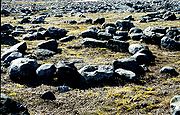
Pinniped
Pinnipeds or fin-footed mammals are a widely distributed and diverse group of semiaquatic marine mammals comprising the families Odobenidae , Otariidae , and Phocidae .-Overview: Pinnipeds are typically sleek-bodied and barrel-shaped...
, walrus
Walrus
The walrus is a large flippered marine mammal with a discontinuous circumpolar distribution in the Arctic Ocean and sub-Arctic seas of the Northern Hemisphere. The walrus is the only living species in the Odobenidae family and Odobenus genus. It is subdivided into three subspecies: the Atlantic...
es and smaller whale
Whale
Whale is the common name for various marine mammals of the order Cetacea. The term whale sometimes refers to all cetaceans, but more often it excludes dolphins and porpoises, which belong to suborder Odontoceti . This suborder also includes the sperm whale, killer whale, pilot whale, and beluga...
s by throwing harpoons from the shore or from sea ice.
- Independence I cultureIndependence I cultureThe Independence I culture was a Paleo-Eskimo culture of peoples who lived in northern Greenland from 2,400 to 1,000 B.C. It is named after Independence Fjord. During this time they coexisted with the Saqqaq culture of southern Greenland...
2300 BCE-1500 BCE
This Paleo-Eskimo culture was named after Independence Fjord
Independence Fjord
Independence Fjord is a large fjord in the eastern part of northern Greenland. It is about long and up to wide. Its mouth, opening to Wandel Sea of the Arctic Ocean is located at...
, where traces of a large settlement were found. Their lodgings were erected on elliptical foundations centered upon box-shaped hearths made of flat stones set on end. These they filled with driftwood, musk ox dung, and bones. They might have started fires with the help of a bow-drill operated by sinews, which was in general use some centuries later.
- Saqqaq cultureSaqqaq cultureThe Saqqaq culture was a Paleo-Eskimo culture in Greenland.-Timeframe:...
2400-900 BCE
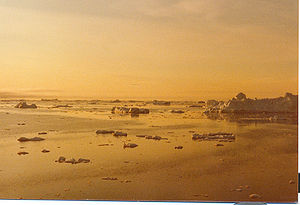
Disko Bay
Disko Bay is a bay on the western coast of Greenland. The bay constitutes a wide southeastern inlet of Baffin Bay.- Geography :To the south the coastline is complicated with multiple waterways of skerries and small islands in the Aasiaat archipelago...
near the place Saqqaq
Saqqaq
Saqqaq is a settlement in the Qaasuitsup municipality, in western Greenland. Founded in 1755, it had 188 inhabitants in 2010. The name of the village means "the sunny side" in Greenlandic.- Geography :...
, which lent its name to the culture. The people extended their culture along the fjords and coastlines in the area. The culture of the Saqqaq people shows marked similarity to the culture that in the Canadian Arctic is described as "Pre-Dorset", and the two cultures developed around the same time. Scholars believe that the people of the Saqqaq split off from the Pre-Dorset culture, migrated into Greenland from Ellesmere Island in the north, and later migrated to the southern coast.
Period IV (1000 BCE-1000 CE)
Western Arctic- Kachemak tradition
- Norton tradition
- Choris, Norton, Ipiutak (in northern Alaska, the forerunners of the ThuleThuleThule Greek: Θούλη, Thoulē), also spelled Thula, Thila, or Thyïlea, is, in classical European literature and maps, a region in the far north. Though often considered to be an island in antiquity, modern interpretations of what was meant by Thule often identify it as Norway. Other interpretations...
)
Eastern Arctic
- Independence II cultureIndependence II cultureThe Independence II culture was a Paleo-Eskimo culture that flourished in northern and northeastern Greenland , north and south of the Independence Fjord. The Independence II culture arose in the same region as the Independence I culture, which became extinct six centuries earlier...
800/600-1 BCE
Presumably for climatic reasons, northern Greenland was not populated for about 500 years afterward. Archeological evidence has shown that before the disappearance of the Saqqaq culture from southern Greenland, a new culture arrived from the Canadian archipelago. The newer people showed a more developed culture from an archaeological standpoint. That culture is called Independence II culture, and it seems to have developed from the Canadian Pre-Dorset cultures. Possibly, they came in close contact with the Saqqaq culture.
The range of distribution of the Independence II people approximately corresponds to that of the Independence I people. The oldest finds have been dated to 1400 BCE, and the most recent to 400 BCE. Researchers have not confirmed whether the farthest northern regions of Greenland were constantly settled during this 1000 year period, because only about 10 dwellings are extant. The climate of that time steadily worsened; the warmest temperature of the Independence II period approximately matches the coldest temperature of the Independence I period.
Archaeological research has focused its fieldwork on areas of Greenland below 83 degrees latitude north for traces of the Independence II culture. In 1987 the remains of a larger Independence II settlement was discovered on the Île-de-France (at about 78 degrees north). The Independence II people hunted the same animals as earlier cultures (seals and musk-oxen), but for the first time also walruses. The houses of the Independence II period were similar to those of the Independence I period, only more complex. So far no connection between the two cultures has been proven. Independence II tools are more reminiscent of the Pre-Dorset and the later Dorset culture. The fate of the Independence II culture is unknown; it is possible that they migrated south along the east coast of Greenland and merged into the Dorset Culture.
- Dorset CultureDorset cultureThe Dorset culture was a Paleo-Eskimo culture that preceded the Inuit culture in Arctic North America. It has been defined as having four phases, with distinct technology related to the people's hunting and tool making...
(500 BCE-1000 CE)
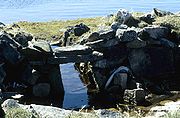
Their hunting methods were greatly improved over previous Arctic cultures. They probably invented the igloo
Igloo
An igloo or snowhouse is a type of shelter built of snow, originally built by the Inuit....
, which is difficult to determine because such ephemeral structures leave no archaeological evidence. They spent the winters in relatively permanent dwellings constructed of stone and pieces of grass; these were the precursors of the later qarmaq
Qarmaq
Qarmaq is an Inuktitut term for a type of inter-seasonal, single-room family dwelling used by Inuit. To the Central Inuit of Northern Canada, it refers to a hybrid of a tent and igloo, or tent and sod house. Depending on the season, the lower portion was constructed of snow blocks or stone, while...
s. They were also the first culture to carve seal-oil lamps (qulliq, also spelled kudlik
Kudlik
Kudlik or qulliq is a type of oil lamp used by the Inuit. The lamp consists of a crescent-shaped cup of carved soapstone, filled with oil from blubber or seal. Arctic cottongrass, common cottongrass, or moss is used as a wick....
) from soapstone
Soapstone
Soapstone is a metamorphic rock, a talc-schist. It is largely composed of the mineral talc and is thus rich in magnesium. It is produced by dynamothermal metamorphism and metasomatism, which occurs in the areas where tectonic plates are subducted, changing rocks by heat and pressure, with influx...
.
In the next 500 years, known as the Dorset II period, the Dorset culture expanded to occupy the region between Victoria Island in the west to Greenland in the east to Newfoundland in the south. A shift in climate, which enabled them to settle high-Arctic regions, probably contributed to this. It is remarkable that the Dorset II culture uniformly maintained the stylistic attributes of the Dorset I culture despite this rapid territorial expansion.
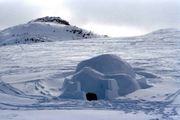
This period's climate was responsible for the Vikings' naming of Iceland
Iceland
Iceland , described as the Republic of Iceland, is a Nordic and European island country in the North Atlantic Ocean, on the Mid-Atlantic Ridge. Iceland also refers to the main island of the country, which contains almost all the population and almost all the land area. The country has a population...
and Greenland
Greenland
Greenland is an autonomous country within the Kingdom of Denmark, located between the Arctic and Atlantic Oceans, east of the Canadian Arctic Archipelago. Though physiographically a part of the continent of North America, Greenland has been politically and culturally associated with Europe for...
, labels that in our times sound paradoxical.
Western Arctic
- Koniaq
- Old Bering Sea
- Okvik
- Birnik
- Punuk
_"Western Thule" of North Alaska
/
-
- Thule---Bering Sea Thule
\
\ __Canadian Thule
\
\____Inugsuk Thule of Greenland
- Thule Culture (1000-1800 CE)

Cultural and technological advancements
The various peoples of the Alaskan coasts had in that period developed entirely new techniques for hunting and fishing; these technologies also fundamentally changed their lifestyle and culture. Developments included boats constructed of watertight seal skin stretched over wooden frames such as the kayakKayak
A kayak is a small, relatively narrow, human-powered boat primarily designed to be manually propelled by means of a double blade paddle.The traditional kayak has a covered deck and one or more cockpits, each seating one paddler...
(Inuktitut: qajag), used by hunters, and the umiaq, a large boat used by groups of up to 20 women; new styles of spears, and harpoons equipped with weights and floats. These technologies enabled the hunting of whales, which provided a valuable source of food (especially whale skin, rich in vitamin C
Vitamin C
Vitamin C or L-ascorbic acid or L-ascorbate is an essential nutrient for humans and certain other animal species. In living organisms ascorbate acts as an antioxidant by protecting the body against oxidative stress...
) and expanded the range of available materials to be processed for construction (bones and skin) and heating (whale oil
Whale oil
Whale oil is the oil obtained from the blubber of various species of whales, particularly the three species of right whale and the bowhead whale prior to the modern era, as well as several other species of baleen whale...
). The development of dog sled
Dog sled
A dog sled is a sled pulled by one or more sled dogs used to travel over ice and through snow. Numerous types of sleds are used, depending on their function. They can be used for dog sled racing.-History:...
s and of igloos that could be entered by a tunnel provided easier travel for the people and warmer dwellings during the winter. All of these advances promoted the formation of new social, religious, and artistic values.
The wave of Thule migrations
The warmer climate of North America in 1000 CE increased the amount of habitable territory in the Arctic and contributed to population growth. Presumably, this development, along with the constant pursuit of quarry into higher latitudes and the search for meteorite iron, was a major impetus for the migration of the Alaskan Thule into northern Canada and Greenland. In the so-called “second migration”, some of the displaced groups migrated south, settling in the Hudson BayHudson Bay
Hudson Bay , sometimes called Hudson's Bay, is a large body of saltwater in northeastern Canada. It drains a very large area, about , that includes parts of Ontario, Quebec, Saskatchewan, Alberta, most of Manitoba, southeastern Nunavut, as well as parts of North Dakota, South Dakota, Minnesota,...
area. As Inuit myths explain, the Dorset-culture residents were assimilated by the technologically superior Thule in most areas but were massacred in others. The Dorset culture subsequently died out throughout the Arctic in a short period around 1000 CE. They held out for a few centuries longer in northern Labrador and in the Ungava region (until about 1300 CE); the isolated Sallirmiut survived until the early 20th century on the southern coasts of Southampton Island and two islands nearby, Walrus Island and Coats Island.
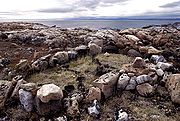
Thule dwellings
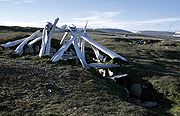
Sod
Sod or turf is grass and the part of the soil beneath it held together by the roots, or a piece of thin material.The term sod may be used to mean turf grown and cut specifically for the establishment of lawns...
. As accommodations for long hunting trips, the Thule used hide-tents in the summer.
Artistic activities
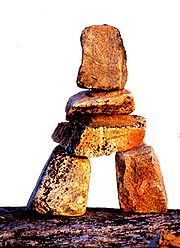
Among the art of the Thule, the depictions of bears especially contrasts with the art of the Dorset. In Dorset art, bears are realistically depicted within stylistic conventions; today, these objects are interpreted as spirit-helpers or amulets against dangers encountered in the hunt. In Thule art, images of bears are limited to carved bear heads that attached to harpoon shafts. Whether they served a decorative or functional purpose is uncertain (probably both). The Thule used bear teeth as jewelry, or hunting trophies. The artifacts left by the Thule generally suggests that they led a more comfortable lifestyle and had leisure time to artistically decorate their personal effects- their art was not the result of social or economic anxieties.
They constructed diverse and numerous Inuksuit (like a man), piled-stone landmarks that survive. Some are examples of an impressive art form.
Transitional Phase (1300-19th century)
From the beginning of the 14th century, a gradual cooling occurred throughout the Canadian ArchipelagoCanadian Arctic Archipelago
The Canadian Arctic Archipelago, also known as the Arctic Archipelago, is a Canadian archipelago north of the Canadian mainland in the Arctic...
and the Arctic Ocean
Arctic Ocean
The Arctic Ocean, located in the Northern Hemisphere and mostly in the Arctic north polar region, is the smallest and shallowest of the world's five major oceanic divisions...
coast of the Mainland. The period between 1550 and 1880, the so-called "Little Ice Age
Little Ice Age
The Little Ice Age was a period of cooling that occurred after the Medieval Warm Period . While not a true ice age, the term was introduced into the scientific literature by François E. Matthes in 1939...
", caused temperatures significantly lower than today's in North America and Europe (with a brief period of higher heat around 1800). The effect of the drop in temperature upon the hunting-dependent lifestyle of the Thule was significant. Entire regions of the high Arctic were depopulated, partly by mass migrations but also by the starvation of entire communities. The traditional way of life was maintained only by communities in the relatively hospitable regions of the Arctic: the southern end of Baffin Island, Labrador, and the southernmost tip of Greenland. In Greenland, the Thule developed a different social structure and new dwelling types, and became what is known as the Inugsuk Culture.
In Greenland, the beginning of the 17th century brought the first European whaling ships and sudden change. In the following 150 years, up to 10,000 whalers would annually pass the coast of Greenland and substantially influence the culture of the Thule living there. The emerging trade relationships made intermarriage with European-Canadians and European-Americans common; there were few genetically pure Inugsuk after several generations.
Historical period of the Inuit (from 1800)
The 19th century is regarded as the beginning of "Inuit culture." Although the Thule traditions endured in a limited way, the living conditions of Inuit in the Historical period were considerably worse than those of their ancestors 1000 years before. The technical standards and spirit of their artwork likewise began to decline. Carving and decorative engraving, for example, became rarer and less differentiated. The colder climate of the period and the resulting decline in animals as game meant that the Inuit were forced to abandon their winter settlements in search of quarry. In their newly nomadic way of life, the Inuit built more temporary winter dwellings. These were tent-like huts constructed of stone, grass, and snow. The Inuit called them qarmaqs. The technique of constructing igloos was further developed and became more widespread.Contact with Europeans
Contact with Europeans was another important impetus for change in the culture of the Inuit. The earliest contacts with the Vikings, later with explorers, fishermen and whalers, affected Canadian Inuit (as opposed to Greenland's) less profoundly and more locally. Those early European arrivals did not intend to settle Canada. Such contacts proved fatal for many Inuit due to the spread of sexually transmitted diseaseSexually transmitted disease
Sexually transmitted disease , also known as a sexually transmitted infection or venereal disease , is an illness that has a significant probability of transmission between humans by means of human sexual behavior, including vaginal intercourse, oral sex, and anal sex...
s, smallpox
Smallpox
Smallpox was an infectious disease unique to humans, caused by either of two virus variants, Variola major and Variola minor. The disease is also known by the Latin names Variola or Variola vera, which is a derivative of the Latin varius, meaning "spotted", or varus, meaning "pimple"...
and other infectious diseases.
In contrast, tradesmen, missionaries and representatives of the Canadian administration established themselves in the region and directly influenced the life of the natives. The Canadians erected the first administrative and police stations in 1903, near the important whaling base of Fullerton Harbour on the Hudson Bay
Hudson Bay
Hudson Bay , sometimes called Hudson's Bay, is a large body of saltwater in northeastern Canada. It drains a very large area, about , that includes parts of Ontario, Quebec, Saskatchewan, Alberta, most of Manitoba, southeastern Nunavut, as well as parts of North Dakota, South Dakota, Minnesota,...
and on Herschel Island
Herschel Island
Herschel Island is an island in the Beaufort Sea , which lies off the coast of the Yukon Territories in Canada, of which it is administratively a part...
northwest of the Mackenzie Delta
Mackenzie Delta (electoral district)
Mackenzie Delta is a territorial electoral district for the Legislative Assembly of the Northwest Territories, Canada. The district consists of Aklavik, Fort McPherson and Tsiigehtchic.-History:...
. In that same year, the Norwegian Roald Amundsen
Roald Amundsen
Roald Engelbregt Gravning Amundsen was a Norwegian explorer of polar regions. He led the first Antarctic expedition to reach the South Pole between 1910 and 1912 and he was the first person to reach both the North and South Poles. He is also known as the first to traverse the Northwest Passage....
started to transit the famous Northwest Passage
Northwest Passage
The Northwest Passage is a sea route through the Arctic Ocean, along the northern coast of North America via waterways amidst the Canadian Arctic Archipelago, connecting the Atlantic and Pacific Oceans...
with his ship Gjøa
Gjøa
Gjøa was the first vessel to transit the Northwest Passage. With a crew of six, Roald Amundsen traversed the passage in a three year journey, finishing in 1906.- History :- Construction :...
on a more southerly course than that of his predecessors, alongside the Canadian mainland.
Starting at the beginning of the 20th century, radical changes occurred for the Arctic people. Greenland was visited with increasing frequency: Alfred Wegener
Alfred Wegener
Alfred Lothar Wegener was a German scientist, geophysicist, and meteorologist.He is most notable for his theory of continental drift , proposed in 1912, which hypothesized that the continents were slowly drifting around the Earth...
led an expedition in 1912-1913, and the Thule expeditions by Knud Rasmussen took place in 1915-1924. In 1933, the Permanent Court of International Justice
Permanent Court of International Justice
The Permanent Court of International Justice, often called the World Court, was an international court attached to the League of Nations. Created in 1922 , the Court was initially met with a good reaction from states and academics alike, with many cases submitted to it for its first decade of...
attested Denmark's authority in Greenland, with cultural, political and structural impacts for the Inuit.
In Canada, the Hudson's Bay Company
Hudson's Bay Company
The Hudson's Bay Company , abbreviated HBC, or "The Bay" is the oldest commercial corporation in North America and one of the oldest in the world. A fur trading business for much of its existence, today Hudson's Bay Company owns and operates retail stores throughout Canada...
tapped the previously unexplored "Barren Lands" of the Kivalliq Region to the west of the Hudson Bay for trade. The Inuit no longer hunted animals for food and clothing, but mainly to acquire goods for barter with the emissaries of markets in the South and in Europe. The fur of the Arctic Fox
Arctic fox
The arctic fox , also known as the white fox, polar fox or snow fox, is a small fox native to Arctic regions of the Northern Hemisphere and is common throughout the Arctic tundra biome. The Greek word alopex, means a fox and Vulpes is the Latin version...
was especially in demand, but other kinds of fur and the ivory of walrus
Walrus
The walrus is a large flippered marine mammal with a discontinuous circumpolar distribution in the Arctic Ocean and sub-Arctic seas of the Northern Hemisphere. The walrus is the only living species in the Odobenidae family and Odobenus genus. It is subdivided into three subspecies: the Atlantic...
es and narwhal
Narwhal
The narwhal, Monodon monoceros, is a medium-sized toothed whale that lives year-round in the Arctic. One of two living species of whale in the Monodontidae family, along with the beluga whale, the narwhal males are distinguished by a characteristic long, straight, helical tusk extending from their...
s were also desirable. Due to trade, the Inuit could acquire goods of the European-Canadian civilization, such as weapons and ammunition, tobacco, coffee, tea, sugar and flour. To keep the hunters associated with the trading posts, the traders lent them traps were lent and extended credit to the Inuit. Becoming more dependent on another people meant that the native society had lost its former self-sufficiency. It changed their cultural development.
19th century social structure and way of life
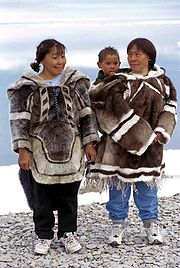
Hunting provided the Inuit with a balanced diet
Inuit diet
Inuit consume a diet of foods that are fished, hunted, and gathered locally. This may include walrus, Ringed Seal, Bearded Seal, beluga whale, caribou, polar bear, muskoxen, birds and fish. While it is not possible to cultivate plants for food in the Arctic the Inuit have traditionally gathered...
and the raw materials for clothing, housing, household implements and heating, boat and sled-building, hunting weapons, toys, and art-objects. Stones, carefully chosen and carved, were used for select but important objects: arrow, spear, and harpoon heads, hide-scrapers, and knives. Soapstone, a relatively soft and easily carved material, was used for the production of oil lamps (qulliqs) and cooking vessels.
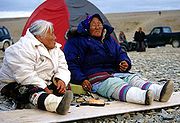
Driftwood
Driftwood is wood that has been washed onto a shore or beach of a sea or river by the action of winds, tides, waves or man. It is a form of marine debris or tidewrack....
. The bones, tusks, and antlers of hunted animals were used in its place. Berries were collected in large numbers during the late summer, but while they provided a source of some vitamins, they were far from sufficient. The people met their vitamin requirements by eating raw animal products, such as maktaaq (whale skin), meat and fish.
The Inuit tradition of living in tents during summer and in igloos and Qarmait (singular: Qarmaq, warm half-subterranean houses made from boulders, whale bones and sod) in winter still followed the Thule practices. The most important principle of all building constructions was the lowered entrance tunnel, which served as a windscreen and cold trap. The inner living area was constructed at a higher level so that the heavier cold air could not easily enter it. Girl children played with string figures within the igloos, as preparation for learning to sew and partly as a ritual act. The girls of the Chugach
Chugach
Chugach is the name of an Alaska Native culture and group of people in the region of the Kenai Peninsula and Prince William Sound. The Chugach people are an Alutiiq people who speak the Chugach dialect of the Alutiiq language....
people mainly played this in autumn because it was believed this weaving captured the sunrays and thus delayed the beginning of winter. Often the creation of string figures was accompanied by rhymes and songs describing tales, legends and myths.
The Inuit had developed winter clothing that ensured an effective use of the body heat, avoiding holes that would allow air to leak out. Apart from seal, mostly caribou skin was used, and in Greenland polar bear fur. In order to create a cushion of warm air, the clothing was loosely tailored and worn in two layers, the outer one with the hair inside, the inner one with the hair outside. In summer, only the inner layer was worn. The hood fixed on the inside of the coat avoided the leaking of warm air at the neck. Mothers used an additional part of their hoods for carrying the toddlers in their parka (amauti
Amauti
The amauti is the traditional eastern Arctic Inuit parka designed to carry a child in the same garment as the parent so that the child is warm and safe from frostbite, wind and cold. The amauti can be made from a variety of materials including sealskin, caribou skin or duffle with a windproof...
).
Nomadic life in the first half of the 20th century
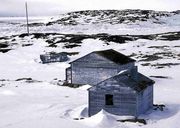
At the turn to the 20th century, most Inuit still lived in hide tents during the summer. Sometimes, they already owned canvas tents obtained from the Hudson's Bay Company
Hudson's Bay Company
The Hudson's Bay Company , abbreviated HBC, or "The Bay" is the oldest commercial corporation in North America and one of the oldest in the world. A fur trading business for much of its existence, today Hudson's Bay Company owns and operates retail stores throughout Canada...
. Ther interior was divided into a back part used for sleeping, usually raised by coat underlays, and a front part for cooking and living; a tradition still in practice today. The woman's sleeping place was always beside the kudlik
Kudlik
Kudlik or qulliq is a type of oil lamp used by the Inuit. The lamp consists of a crescent-shaped cup of carved soapstone, filled with oil from blubber or seal. Arctic cottongrass, common cottongrass, or moss is used as a wick....
, an oil lamp usually carved from soapstone
Soapstone
Soapstone is a metamorphic rock, a talc-schist. It is largely composed of the mineral talc and is thus rich in magnesium. It is produced by dynamothermal metamorphism and metasomatism, which occurs in the areas where tectonic plates are subducted, changing rocks by heat and pressure, with influx...
used for lighting, heating and cooking, because it was her duty to operate it. The man's sleeping place was near the weapons and hunting equipment; the children were nestled between their parents for warmth. Today the kudlik is replaced by a product of modern industry, the Coleman
Coleman Company
Coleman Company, Inc., is an American company that specializes in outdoor recreation products. Historically, Coleman is known for camping gear....
stove
Portable stove
A portable stove is a cooking stove specially designed to be portable and lightweight, as for camping or picnicking, or for use in remote locations where an easily transportable means of cooking or heating is needed...
, which is easy to transport and operated by gasoline
Gasoline
Gasoline , or petrol , is a toxic, translucent, petroleum-derived liquid that is primarily used as a fuel in internal combustion engines. It consists mostly of organic compounds obtained by the fractional distillation of petroleum, enhanced with a variety of additives. Some gasolines also contain...
and naphtha
Naphtha
Naphtha normally refers to a number of different flammable liquid mixtures of hydrocarbons, i.e., a component of natural gas condensate or a distillation product from petroleum, coal tar or peat boiling in a certain range and containing certain hydrocarbons. It is a broad term covering among the...
.

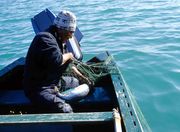
Arctic char
Arctic char or Arctic charr is both a freshwater and saltwater fish in the Salmonidae family, native to Arctic, sub-Arctic and alpine lakes and coastal waters. No other freshwater fish is found as far north. It is the only species of fish in Lake Hazen, on Ellesmere Island in the Canadian Arctic...
, e.g. by using artificial weirs, and the eggs of seabirds. For the inland Inuit, the caribou was the most important resource; it provided meat, a hide for clothing, and sinew for rope. The coastal Inuit hunted mostly pinniped
Pinniped
Pinnipeds or fin-footed mammals are a widely distributed and diverse group of semiaquatic marine mammals comprising the families Odobenidae , Otariidae , and Phocidae .-Overview: Pinnipeds are typically sleek-bodied and barrel-shaped...
s and walrus
Walrus
The walrus is a large flippered marine mammal with a discontinuous circumpolar distribution in the Arctic Ocean and sub-Arctic seas of the Northern Hemisphere. The walrus is the only living species in the Odobenidae family and Odobenus genus. It is subdivided into three subspecies: the Atlantic...
es and, depending on the region, narwhal
Narwhal
The narwhal, Monodon monoceros, is a medium-sized toothed whale that lives year-round in the Arctic. One of two living species of whale in the Monodontidae family, along with the beluga whale, the narwhal males are distinguished by a characteristic long, straight, helical tusk extending from their...
s and Belugas; of course also the occasional caribou. The seals were used for food for men and dogs. Their oil was used for the kudliks, and their skin and sinews for seal boots (kamik), kayak coverings, ropes (also drag ropes for dog sleds) and dog whips.
During the winter, the Inuit lived in igloos, which were erected separately or connected by tunnels. Snow of a specific consistency was necessary to build them. They had the same general interior arrangement as the tents. The most important element was a lowered entrance tunnel, repelling the heavier cold air and the wind from entering inside. As additional prevention against cold, the sleeping area was elevated by a layer of snow as compared to the living area.
Some of the families that wanted to live in permanent camps, built themselves a partially subsurface home of rocks, whale bones, coat and sod, the so-called Qarmaq. The construction of such camps is certainly based on the Thule tradition. During the winter, they used quarmaqs, but in summer preferred the more airy tents.
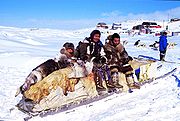
Dog sled
A dog sled is a sled pulled by one or more sled dogs used to travel over ice and through snow. Numerous types of sleds are used, depending on their function. They can be used for dog sled racing.-History:...
s, partly presumably also by foot.
During the warmer seasons, mainly the people used the kayak
Kayak
A kayak is a small, relatively narrow, human-powered boat primarily designed to be manually propelled by means of a double blade paddle.The traditional kayak has a covered deck and one or more cockpits, each seating one paddler...
, or, mostly as "women boat" for families, the large umiak
Umiak
The umiak, umialak, umiaq, umiac, oomiac or oomiak is a type of boat used by Eskimo people, both Yupik and Inuit, and was originally found in all coastal areas from Siberia to Greenland. First arising in Thule times, it has traditionally been used in summer to move people and possessions to...
, and traveled by foot. Traditional land routes were, e.g., from Wager Bay
Wager Bay
Wager Bay is a waterway in Kivalliq Region, Nunavut, Canada. It is located in Hudson Bay. Ukkusiksalik National Park surrounds it.Wager Bay was first charted by Christopher Middleton during his Arctic explorations of 1742....
to Repulse Bay
Repulse Bay, Nunavut
Repulse Bay is an Inuit hamlet located on the shore of Hudson Bay, Kivalliq Region, in Nunavut, Canada.-Location and wildlife:The hamlet is located exactly on the Arctic Circle, on the north shore of Repulse Bay and on the south shore of the Rae Isthmus. Transport to the community is provided...
in North, to the Chesterfield Inlet
Chesterfield Inlet
Chesterfield Inlet is an inlet in Kivalliq Region, Nunavut, Canada. It is an arm of northwestern Hudson Bay, and the end point of the Thelon River after its passage through Baker Lake. Cross Bay, a large widening of the inlet, occurs east of Baker Lake...
with the adjacent Baker Lake
Baker Lake, Nunavut
Baker Lake , is a hamlet in the Kivalliq Region, in Nunavut on mainland Canada. Located inland from Hudson Bay, it is near the nation's geographical centre, and is notable for being the Canadian Arctic's sole inland community...
in Southwest and to the Chantrey Inlet
Chantrey Inlet
The Back River reaches the Arctic Ocean at Chantrey Inlet on the east side of Adelaide Peninsula, Nunavut, Canada. Montreal Island is contained within the Inlet, while King William Island shelters the Inlet. It is long and wide at its mouth...
at the Arctic Ocean
Arctic Ocean
The Arctic Ocean, located in the Northern Hemisphere and mostly in the Arctic north polar region, is the smallest and shallowest of the world's five major oceanic divisions...
in Northwest.
Fundamental change of living conditions
Between 1800 and 1950, the culture and way of living of the Canadian Inuit, who had not known any monetary system before, changed fundamentally. Complete self-sufficiency and independence were to a large extent replaced by dependence on goods of western industrialized countries, such as clothing, many kinds of foodstuffs, weapons, tools and technical equipment. This development was largely due to the fact that as hunters and trappers, they could develop only a low level of productivity that could not financially cover the Western way of living. Moreover, the products of the kill depended too much on market and fashion fluctuations, not to speak of concerns related to protection of species and of the environment.
Cold War
The Cold War was the continuing state from roughly 1946 to 1991 of political conflict, military tension, proxy wars, and economic competition between the Communist World—primarily the Soviet Union and its satellite states and allies—and the powers of the Western world, primarily the United States...
strategic defense concept, and military and radar stations of the Distant Early Warning Line
Distant Early Warning Line
The Distant Early Warning Line, also known as the DEW Line or Early Warning Line, was a system of radar stations in the far northern Arctic region of Canada, with additional stations along the North Coast and Aleutian Islands of Alaska, in addition to the Faroe Islands, Greenland, and Iceland...
(DEW Line) were established. Although this developed the infrastructure and created jobs, it also led to a sudden urbanization that not every community could adapt to. Traditional ways of living were increasingly constrained and eliminated, with no provision made for the transition to the new way of living. The transitional difficulties were further enhanced, for example, by the fact that at the end of the 1940s, the Kivalliq Region had to be placed under quarantine
Quarantine
Quarantine is compulsory isolation, typically to contain the spread of something considered dangerous, often but not always disease. The word comes from the Italian quarantena, meaning forty-day period....
because of the appearance of serious infectious diseases such as polio (for which there was as yet no vaccine
Vaccine
A vaccine is a biological preparation that improves immunity to a particular disease. A vaccine typically contains an agent that resembles a disease-causing microorganism, and is often made from weakened or killed forms of the microbe or its toxins...
). At the same time, the caribou population west of the Hudson Bay
Hudson Bay
Hudson Bay , sometimes called Hudson's Bay, is a large body of saltwater in northeastern Canada. It drains a very large area, about , that includes parts of Ontario, Quebec, Saskatchewan, Alberta, most of Manitoba, southeastern Nunavut, as well as parts of North Dakota, South Dakota, Minnesota,...
nearly perished. As a consequence, the Inuit of that area lost their food supply. Those Inuit still mostly living in camps faced an increasing threat from tuberculosis
Tuberculosis
Tuberculosis, MTB, or TB is a common, and in many cases lethal, infectious disease caused by various strains of mycobacteria, usually Mycobacterium tuberculosis. Tuberculosis usually attacks the lungs but can also affect other parts of the body...
; many who contracted the disease had to be treated in sanatoriums in the south. Many Inuit tried to continue their traditional way of living in their ancestral regions while adapting to the new conditions. But, they became more dependent on governmental welfare.
The Canadian state had primarily scientific interest in its northern regions during the first half of the century. Beginning in the 1950s, it became concerned about three issues: military security requirements, discovery of economically important natural resources, and an increasing sensibility for the special concerns of the Inuit. The government felt the need to exercise governmental control and sovereignty over the territory. The Canadian government created a Department of Indian Affairs and Natural Resources in 1953 (now Indian and Northern Affairs Canada
Indian and Northern Affairs Canada
The Department of Aboriginal Affairs and Northern Development is the department of the government of Canada with responsibility for policies relating to Aboriginal peoples...
). This department established social benefits such as unemployment aid, social welfare, care of the sick and of the elderly, child allowance, comprehensive educational and welfare programs of the industrial areas of Canada. At the same time, the Canadian government forcibly moved
High Arctic relocation
The High Arctic relocation took place during the Cold War in the 1950s, when 87 Inuit were moved by the Government of Canada to the High Arctic....
many Inuit families from their traditional hunting grounds into new and empty areas, to reinforce claims of Canadian sovereignty.

Kitikmeot Region, Nunavut
Kitikmeot Region is an administrative region of Nunavut, Canada. It consists of the southern and eastern parts of Victoria Island with the adjacent part of the mainland as far as the Boothia Peninsula, together with King William Island and the southern portion of Prince of Wales Island...
. The common characteristic was the extensive change from the nomadic to the sedentary way of living. Inuit left their camps and moved into settlements with permanent buildings. The wooden building replaced the igloo, qarmaq and tents originally made from hide. Since then, the Inuit have lived in residential buildings prefabricated in the south of Canada and - because of permafrost
Permafrost
In geology, permafrost, cryotic soil or permafrost soil is soil at or below the freezing point of water for two or more years. Ice is not always present, as may be in the case of nonporous bedrock, but it frequently occurs and it may be in amounts exceeding the potential hydraulic saturation of...
- built on stilts. These buildings are heated with oil stoves (every building has a holding tank for heating oil). Fresh water is delivered by tankers, and waste water is brought away the same way. The buildings contain cooking sites with electric range, sink, and freezer; a bathroom with shower and/or bathtub, and flushing toilet; washers and dryers have become common. Like other westerners, many households keep their TV sets on almost 24 hours a day. The people use fax machines and e-mail for correspondence.
Marriage
Childhood of the Inuit was still very brief the first half of the 20th century. Especially girls entered marriage at an early ageChild marriage
Child marriage and child betrothal customs occur in various times and places, whereby children are given in matrimony - before marriageable age as defined by the commentator and often before puberty. Today such customs are fairly widespread in parts of Africa, Asia, Oceania and South America: in...
. Before the arrival of Christian missionaries, it was mostly the families who decided which children should marry whom, i.e. arranged marriage
Arranged marriage
An arranged marriage is a practice in which someone other than the couple getting married makes the selection of the persons to be wed, meanwhile curtailing or avoiding the process of courtship. Such marriages had deep roots in royal and aristocratic families around the world...
s. Marriages often served to strengthen family ties, and girls had no say in choosing their partners. Sometimes a young man who had not yet been pledged, sent to the parents of the girl, without being personally present in those negotiations. The wedding was completely unceremonial (the same was true for birthdays). After Christianization, the only change was that now the couples also received Christian marriage ceremonies whenever a priest traveled their areas (often months after the actual marriage). When finally government administration had been established, marriages were also registered by the administration, initially by police officers, later by the local administrations. Since moving from the camps to the settlements, more couples live together without marriage. This way, they feel less tied but also less responsible. But still in the 1970s, it was in no way unusual to make agreements regarding newborns about eventual marriages. However with these promises of marriage becoming due now (i.e. twenty or thirty years later), they are taken less and less serious: The young people increasingly defy tradition and follow their own wishes.
Before Christianizing (referred to as Siqqitiq
Siqqitiq
Siqqitiq is the ritual of converting Inuit with shamanist beliefs to Christianity. This is usually accompanied by ritualistic consumption of foods held taboo by shamanist belief , to underscore the fact that such taboos no longer apply...
by the Inuit), polygamy
Polygamy
Polygamy is a marriage which includes more than two partners...
, more often polygyny
Polygyny
Polygyny is a form of marriage in which a man has two or more wives at the same time. In countries where the practice is illegal, the man is referred to as a bigamist or a polygamist...
, less so polyandry
Polyandry
Polyandry refers to a form of marriage in which a woman has two or more husbands at the same time. The form of polyandry in which a woman is married to two or more brothers is known as "fraternal polyandry", and it is believed by many anthropologists to be the most frequently encountered...
, were not unusual among the Inuit. Extramarital relationships were accepted especially during extensive hunting trips, and there were so-called "lamp extinction games" with ritual partner exchanges. According to a popular theory, these traditions reduced the danger of inbreeding
Inbreeding
Inbreeding is the reproduction from the mating of two genetically related parents. Inbreeding results in increased homozygosity, which can increase the chances of offspring being affected by recessive or deleterious traits. This generally leads to a decreased fitness of a population, which is...
and resulting population bottleneck
Population bottleneck
A population bottleneck is an evolutionary event in which a significant percentage of a population or species is killed or otherwise prevented from reproducing....
in small and isolated settlements. With colonization, these customs led to great conflicts: On one hand such traditions were fought by missionaries as sin
Sin
In religion, sin is the violation or deviation of an eternal divine law or standard. The term sin may also refer to the state of having committed such a violation. Christians believe the moral code of conduct is decreed by God In religion, sin (also called peccancy) is the violation or deviation...
ful, on the other, they were interpreted as sexual arbitrariness and taken advantage of, often leading to prostitution and sexual exploitation.
Family life
_1997-04-28.jpg)
Kudlik
Kudlik or qulliq is a type of oil lamp used by the Inuit. The lamp consists of a crescent-shaped cup of carved soapstone, filled with oil from blubber or seal. Arctic cottongrass, common cottongrass, or moss is used as a wick....
, etc. (their participation in hunting and fishing was limited). Whenever a family lost its breadwinner (for example in an accident), it was usually dependent on support by other families, and the widow was sometimes adopted as additional wife by a close relative of the deceased (see widow inheritance
Widow inheritance
Widow inheritance, also known as bride inheritance, is a type of marriage in which a widow marries a kinsman of her late husband, often his brother....
).
The move from the camps to the settlements, which essentially took place during the 1950s, brought about significant changes in this respect: The Inuit now were immediate subjects of governmental administration and care (also social welfare). By occupations that were completely new to them, like in health care and local administration, but also in Inuit arts, the women with their earned money were able to contribute like the men to the livelihood of their families. Nowadays, the division of tasks and responsibilities between male and female Inuit are, following Canadian legislation, not very different from western industrialized nations, of which the Inuit are considered part. In the Territory of Nunavut, female representatives and ministers are as common as their male counterparts. There are Inuit municipalities with female mayors, for example.
Birth

Churchill, Manitoba
Churchill is a town on the shore of Hudson Bay in Manitoba, Canada. It is most famous for the many polar bears that move toward the shore from inland in the autumn, leading to the nickname "Polar Bear Capital of the World" that has helped its growing tourism industry.-History:A variety of nomadic...
.
Death

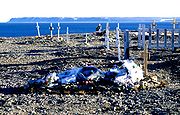
Similar burial customs have been found through the centuries. For example, Qilakitsoq
Qilakitsoq
Qilakitsoq is an archaeological site on Nuussuaq Peninsula, on the shore of Uummannaq Fjord in northwestern Greenland. Formally a settlement, it is famous for the discovery of eight mummified bodies in 1972.- Archaeological finds :...
mummies
Mummy
A mummy is a body, human or animal, whose skin and organs have been preserved by either intentional or incidental exposure to chemicals, extreme coldness , very low humidity, or lack of air when bodies are submerged in bogs, so that the recovered body will not decay further if kept in cool and dry...
dating from 500 years ago show that the Thule people
Thule people
The Thule or proto-Inuit were the ancestors of all modern Inuit. They developed in coastal Alaska by AD 1000 and expanded eastwards across Canada, reaching Greenland by the 13th century. In the process, they replaced people of the earlier Dorset culture that had previously inhabited the region...
, ancestors of the present Inuit, wrapped and protected their dead the same way.
The Inuit believed the aurora borealis
Aurora (astronomy)
An aurora is a natural light display in the sky particularly in the high latitude regions, caused by the collision of energetic charged particles with atoms in the high altitude atmosphere...
to be visible signals from the dead. Children feared the ghosts of those deceased long ago and often whistled or blew air against their hands, in order to "blow away" those supernatural beings. In pre-missonary times it was usual to give a newborn child the name of a close relative who had died shortly before. This way, ancestors could experience a kind of return to a new life in the child. This customs has survived to this day, although the traditional animism
Animism
Animism refers to the belief that non-human entities are spiritual beings, or at least embody some kind of life-principle....
religion has largely given way to Christianity.
Since the move to the settlements, the dead are buried in cemeteries. All members of the community participate in requiems that last for hours, during which the towns appear deserted. Due to the frozen permafrost
Permafrost
In geology, permafrost, cryotic soil or permafrost soil is soil at or below the freezing point of water for two or more years. Ice is not always present, as may be in the case of nonporous bedrock, but it frequently occurs and it may be in amounts exceeding the potential hydraulic saturation of...
, burial sites are not deep, and are covered with rocks. Sometimes a blue plastic layer can be detected between the rocks. Here and there, a wooden box with a vitrified cover a few fading artificial flowers and other decorations can be seen. Crosses stand askew on the shifting permafrost. The inscriptions show that many of the dead are children, victims of accidents or natural disasters, and also suicides. Often there is a wooden hut outside of the town, where the dead of winter are preserved in natural cold, until the warmer season permits their burial.
Challenges by changed walks of life
Given such changes in their way of life, keeping their own identity and recollection of history and ancestors proved to be an extraordinary challenge many Inuit could not meet. These changes led to alcohol and drug problems. The suicide rate of the Inuit rose four times as high as the one of the remaining population of Canada.Although nowadays the mortality rate
Mortality rate
Mortality rate is a measure of the number of deaths in a population, scaled to the size of that population, per unit time...
is still high and the lifespan relatively short, the Inuit population has grown considerably during the past 40 years. Today, about 50,000 Inuit live in Canada, distributed among some 70 settlements, some of which have a population of a few hundred only. They account for about 1.6 ‰ of the total population of Canada.
Within a very short time, modern technology replaced methods and technologies that had been passed on for centuries. Firearms replaced lances and harpoons, snow mobiles, mainly Polaris
Polaris Industries
Polaris Industries is a manufacturer of snowmobiles, ATV, and neighborhood electric vehicles. Polaris is based in Medina, Minnesota, USA. The company also manufactures motorcycles through its Victory Motorcycles subsidiary and through the Indian Motorcycle subsidiary which it purchased in April...
, Ski-Doo
Ski-Doo
Ski-Doo is a brand name of snowmobile fabricated by Bombardier Recreational Products. The first Ski-Doo was launched in 1959. It was a new invention Joseph-Armand Bombardier...
and Yamaha
Yamaha Motor Company
, is a Japanese motorized vehicle-producing company. Yamaha Motor is part of Yamaha Corporation and its headquarter is located in Iwata, Shizuoka. Along with expanding Yamaha Corporation into the world's biggest piano maker, then Yamaha CEO Genichi Kawakami took Yamaha into the field of motorized...
took the place of dog sled teams (the name Ski-doo is often used for the whole category, since Joseph-Armand Bombardier
Joseph-Armand Bombardier
Joseph-Armand Bombardier was a Canadian inventor and businessman, and was the founder of Bombardier...
1922 built the first snow mobile Ski-dog, which mutated to Ski-doo by a typographical error). ATVs (all-terrain vehicle
All-terrain vehicle
An all-terrain vehicle , also known as a quad, quad bike, three wheeler, or four wheeler, is defined by the American National Standards Institute as a vehicle that travels on low pressure tires, with a seat that is straddled by the operator, along with handlebars for steering control...
s, quad-bikes) became widely accepted as a general means of transportation..
The Inuit have become consumers who make their living by fishing, hunting, trapping and production of artwork. They also perform wage labor, and often must be supported by additional social welfare. Government support is often the only source of income. The number of recipients is much higher than the average of Canada. Also, the share of employees in public service is 20 to 30 percent, compared to 7 percent for Canada. This is extremely high, and has been rising even higher since the creation of Nunavut
Nunavut
Nunavut is the largest and newest federal territory of Canada; it was separated officially from the Northwest Territories on April 1, 1999, via the Nunavut Act and the Nunavut Land Claims Agreement Act, though the actual boundaries had been established in 1993...
Territory. Nowadays only a few areas are left where traditional methods of hunting and fishing have been preserved in their original form.
Adjustment to conditions of living in a modern industrial nation
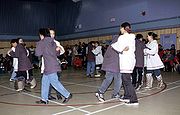
The proselytizing by the Anglican Church and the Roman Catholic Church
Roman Catholic Church
The Catholic Church, also known as the Roman Catholic Church, is the world's largest Christian church, with over a billion members. Led by the Pope, it defines its mission as spreading the gospel of Jesus Christ, administering the sacraments and exercising charity...
in the first half of the 20th century, which must be critically viewed in some respect, was also of fundamental significance for the cultural change of the Inuit. Although the Arctic nowadays is considered largely Christian, elements of Shamanism
Shamanism
Shamanism is an anthropological term referencing a range of beliefs and practices regarding communication with the spiritual world. To quote Eliade: "A first definition of this complex phenomenon, and perhaps the least hazardous, will be: shamanism = technique of ecstasy." Shamanism encompasses the...
appear to persist fairly well at the subliminal level, side by side with Christian thought, despite its condemnation by the missionaries.
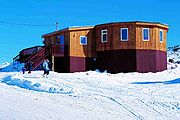
Inuktitut
Inuktitut or Eastern Canadian Inuktitut, Eastern Canadian Inuit language is the name of some of the Inuit languages spoken in Canada...
is the relevant language of instruction. In many schools of the Arctic, "elders", older residents who are recognized for their experience, are teaching knowledge about culture, customs and way of living from the pre-settlement time, during planned lectures. Despite all efforts, the number of dropout is generally rather high, because of lack of motivation, among other reasons.

There has been no lack of intensive effort to find ways for the Inuit into a largely self-designed future, and to help them with a recollection of their own values and of their personal identity. It was important in this context to convey a new role of men and women. In the past, the man was responsible for family life and survival, while the women in the camp were charged with the young. Now often both of them have to master new tasks, thereby skipping several stages of development, with this process taking a course different from what happened in the European cultural area. It is not seldom that the woman assumes the sole role of the breadwinner, while the man is unemployed.
Cooperatives, a formula for success
Big hopes were put into the establishment of cooperatives that were to help convey to the Inuit the skills of creating added value, so they would take care of themselves again and at the same time preserve their traditional culture. These cooperatives, mostly managed by Qallunaat (non-Inuit), did in fact prove very successful, because they succeeded in connecting economic thinking with traditional activities and values not only theoretically.The cooperatives developed activities in disparate areas. They were active in the provisioning of goods and services, such as trading with oil, gas, gasoline and construction materials, the organization of supermarkets with foodstuffs, clothing and technical goods, of hotels and restaurants, the construction of recreational and tourism facilities. On the regional level, the cooperatives ran commercial fur trade and fishing, as well as the production of downs and feathers.

Inuit art
Inuit art refers to artwork produced by Inuit people, that is, the people of the Arctic previously known as Eskimos, a term that is now often considered offensive outside Alaska...
, i.e. of artistic and crafted objects, mainly sculpture
Sculpture
Sculpture is three-dimensional artwork created by shaping or combining hard materials—typically stone such as marble—or metal, glass, or wood. Softer materials can also be used, such as clay, textiles, plastics, polymers and softer metals...
s made from serpentine
Serpentinite
Serpentinite is a rock composed of one or more serpentine group minerals. Minerals in this group are formed by serpentinization, a hydration and metamorphic transformation of ultramafic rock from the Earth's mantle...
, steatite and marble
Marble
Marble is a metamorphic rock composed of recrystallized carbonate minerals, most commonly calcite or dolomite.Geologists use the term "marble" to refer to metamorphosed limestone; however stonemasons use the term more broadly to encompass unmetamorphosed limestone.Marble is commonly used for...
, and soon afterwards also of graphics
Graphics
Graphics are visual presentations on some surface, such as a wall, canvas, computer screen, paper, or stone to brand, inform, illustrate, or entertain. Examples are photographs, drawings, Line Art, graphs, diagrams, typography, numbers, symbols, geometric designs, maps, engineering drawings,or...
(drawings, lithotomies, lithographs, erasures) and tapestry
Tapestry
Tapestry is a form of textile art, traditionally woven on a vertical loom, however it can also be woven on a floor loom as well. It is composed of two sets of interlaced threads, those running parallel to the length and those parallel to the width ; the warp threads are set up under tension on a...
(for example hangings), yielded excellent economic and cultural successes.
In the course of the past 50 years this branch of the cooperatives reached an extraordinary importance for value added
Added value
Added value in financial analysis of shares is to be distinguished from value added. Used as a measure of shareholder value, calculated using the formula:...
in the Inuit regions, and clearly ranks first, far ahead of trading hunting products: antlers, fur, or ivory
Ivory
Ivory is a term for dentine, which constitutes the bulk of the teeth and tusks of animals, when used as a material for art or manufacturing. Ivory has been important since ancient times for making a range of items, from ivory carvings to false teeth, fans, dominoes, joint tubes, piano keys and...
, but overproduction is a growing problem. There is a similar problem with this type of art in Greenland, like the tupilaks from East Greenland
Tunu
Tunu/Østgrønland was one of the three counties of Greenland, until 31 December 2008. The county seat was at the main settlement, Tasiilaq...
made from walrus
Walrus
The walrus is a large flippered marine mammal with a discontinuous circumpolar distribution in the Arctic Ocean and sub-Arctic seas of the Northern Hemisphere. The walrus is the only living species in the Odobenidae family and Odobenus genus. It is subdivided into three subspecies: the Atlantic...
ivory.
In 1965, the turnover of Inuit cooperatives with trade of artistic objects and true arts was still below 100,000 Canadian Dollars, but two or three decades later it has risen to 5 Million Dollars, at gross prices, respectively (turnover not registered is estimated at a few additional Million Dollars). Despite manifold attempts in expanding the areas of activity, real added value still occurs mainly in the consumer goods sector, and scarcely in the real branch of production.
Current developments
During a period of five thousand years, the Eskimo groups have grown apart ethnically. However, the increasing integration into nations foreign to them that were extending into the Arctic made them realize after World War IIWorld War II
World War II, or the Second World War , was a global conflict lasting from 1939 to 1945, involving most of the world's nations—including all of the great powers—eventually forming two opposing military alliances: the Allies and the Axis...
that they could maintain their cultural identity
Cultural identity
Cultural identity is the identity of a group or culture, or of an individual as far as one is influenced by one's belonging to a group or culture. Cultural identity is similar to and has overlaps with, but is not synonymous with, identity politics....
only if they appeared united at the international level. Therefore the Eskimo groups of Canada united with their relatives in Alaska and Greenland (after the dissolution of the Soviet Union
Dissolution of the Soviet Union
The dissolution of the Soviet Union was the disintegration of the federal political structures and central government of the Union of Soviet Socialist Republics , resulting in the independence of all fifteen republics of the Soviet Union between March 11, 1990 and December 25, 1991...
also with the Siberian Chukchi
Chukchi people
The Chukchi, or Chukchee , ) are an indigenous people inhabiting the Chukchi Peninsula and the shores of the Chukchi Sea and the Bering Sea region of the Arctic Ocean within the Russian Federation. They speak the Chukchi language...
) to the "Pan-Eskimo Movement". This Movement is supported by the Inuit Circumpolar Conference
Inuit Circumpolar Conference
Originally known as the Inuit Circumpolar Conference, the Inuit Circumpolar Council is a multinational non-governmental organization representing the 150,000 Inuit people living in the United States, Canada, Greenland, and Russia.The Conference, which first met in June 1984 in Barrow, Alaska,...
, that was founded in 1977 after a lead time of four years and to which its protagonist Eben Hopson (North Slope Borough, Alaska) was invited with his vision of constituting a unified, independent Eskimo nation.
During the 1980s and 1990s a nationalistic trend could indeed be felt, and there was no lack of wishful thinking to achieve the dream of circumpolar unity. But in the reality of daily life, rational and last but not least fiscal thinking prevailed.
Nunavut

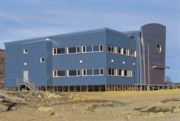
The Canadian Inuit, just like the other indigenous peoples (First Nations
First Nations
First Nations is a term that collectively refers to various Aboriginal peoples in Canada who are neither Inuit nor Métis. There are currently over 630 recognised First Nations governments or bands spread across Canada, roughly half of which are in the provinces of Ontario and British Columbia. The...
) of Canada, grew the demand for collective ethnic rights and a territory of their on, with a government composed of their kind, and Inuktitut
Inuktitut
Inuktitut or Eastern Canadian Inuktitut, Eastern Canadian Inuit language is the name of some of the Inuit languages spoken in Canada...
as one of the official languages. On the federal level, the Inuit got the right to vote in 1962. The first Inuk to be elected Member of Parliament was Peter Ittinuar in 1979. In 1976, the organization Inuit Tapirisat ("Inuit Brotherhood") for the first time demanded the creation of a separate territory in the northeast of Canada. After more than 15 years of negotiation between Inuit and the Federal and Territorial Governments, finally an agreement was reached, the so-called "Nunavut settlement", which determined that from April 1, 1999, the north of Canada should be composed of three territories: Yukon Territory, Nunavut
Nunavut
Nunavut is the largest and newest federal territory of Canada; it was separated officially from the Northwest Territories on April 1, 1999, via the Nunavut Act and the Nunavut Land Claims Agreement Act, though the actual boundaries had been established in 1993...
and the remaining Northwest Territories
Northwest Territories
The Northwest Territories is a federal territory of Canada.Located in northern Canada, the territory borders Canada's two other territories, Yukon to the west and Nunavut to the east, and three provinces: British Columbia to the southwest, and Alberta and Saskatchewan to the south...
. Like the two other territories, Nunavut was placed under direct control of the Canadian federal government and received increasing administrative autonomy. The Inuit have substantial local rights of control. They participate in the execution of important administrative positions, including police, legal and social welfare offices. Inuktitut is official government language, besides English and French.
Accord of Nunavik
An accord (Agreement of James BayJames Bay
James Bay is a large body of water on the southern end of Hudson Bay in Canada. Both bodies of water extend from the Arctic Ocean. James Bay borders the provinces of Quebec and Ontario; islands within the bay are part of Nunavut...
and North Québec) between the Canadian federal government, the Province of Québec and Inuit representatives resulted in the establishment of a Kativik regional government and gave a bigger political autonomy to the Nunavik
Nunavik
Nunavik comprises the northern third of the province of Quebec, Canada. Covering a land area of 443,684.71 km² north of the 55th parallel, it is the homeland of the Inuit of Quebec...
region. As a result, all residents of the 14 Nunavik settlements elect their own representative in regional elections.
Settlement of land claims and titles
An important chapter of Canadian Arctic policy regarding development of the Inuit culture is reflected in the agreements settling Inuit land claimsLand claims
Land claims are a legal declaration of desired control over areas of property including bodies of water. The phrase is usually only used with respect to disputed or unresolved land claims...
opposed to the Canadian state. The advancing exploitation of the Canadian Arctic and if its mineral resources led to ever more conflicts about land ownership and title between Inuit representatives and Federal Government. Land that is not under private ownership is considered as Federal land, but the Inuit claim large areas that they have inhabited and utilized for many centuries. The agreement reached in 1984 regarding land claims of the Inuvialuit
Inuvialuit
The Inuvialuit or Western Canadian Inuit are Inuit people who live in the western Canadian Arctic region. They, like all other Inuit, are descendants of the Thule who migrated eastward from Alaska...
(relatives of the Inuit in the western Arctic) provided means to improve the situation of the indigenous residents of this region, by assuring 91,000 square kilometers of land to 2,500 Inuvialuit, as well as monetary compensation, funds for improving the social structure, hunting right, and more influence on dealing with the fauna, on natural and environmental protection.
The final agreement signed in 1993 with the Tunngavik Federation of Nunavut
Tunngavik Federation of Nunavut
The Tunngavik Federation of Nunavut was the organization officially recognized from 1982 to 1993 as representing the Inuit of what is now Nunavut, but was then part of the Northwest Territories, for the purpose of negotiating treaties and land claims settlements...
is the most comprehensive agreement ever reached in Canada. As a result, about 17,500 Inuit receive 350,000 square kilometers of land, monetary compensation, a share of the profits from exploiting the mineral resources, hunting rights and a larger voice in questions regarding land and environment.
Also in the north of the province of Québec, land claims of Inuit groups were settled successfully. In addition, there are ongoing negotiations with the Association of Labrador Inuit, which represents about 3,800 Inuit living in the interiour and on the eastern coast of Labrador
Labrador
Labrador is the distinct, northerly region of the Canadian province of Newfoundland and Labrador. It comprises the mainland portion of the province, separated from the island of Newfoundland by the Strait of Belle Isle...
, a part of Newfoundland
Newfoundland and Labrador
Newfoundland and Labrador is the easternmost province of Canada. Situated in the country's Atlantic region, it incorporates the island of Newfoundland and mainland Labrador with a combined area of . As of April 2011, the province's estimated population is 508,400...
province.
Traditional Inuit culture and self-determined life
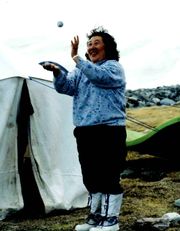
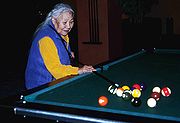
Preservation of tradition and culture
In general, the government of Nunavut sees one of its most important tasks to be the preservation and care of Inuit tradition and culture. Currently, it puts great effort into recording and archiving the oral accounts of "Elders" about the time before the move of the Inuit into the settlements. It is high time for this, because the number of Elders with this knowledge are dwindling.Contemporary literature
A special part of the century-old cultural heritage of the Inuit are their myths and legendsInuit mythology
Inuit mythology has many similarities to the religions of other polar regions. Inuit traditional religious practices could be very briefly summarised as a form of shamanism based on animist principles....
, which had been passed exclusively by word of mouth, because the Inuit had no written language and consequently had no literary tradition. In the Inuit culture story telling had the function that in other cultures literature has. The oral recital of passed-on knowledge gave the Inuit families particularly a feeling of immediate togetherness. At the same time, narrating made a connection between past and present, because the essential statements had been passed from generation to generation and accepted as the truth, without reservations. Among the Inuit, there are even nowadays no authors in the strict sense: writers mainly produce reports, summaries and essays about traditional contexts, or their own experiences ("non-fiction
Non-fiction
Non-fiction is the form of any narrative, account, or other communicative work whose assertions and descriptions are understood to be fact...
"), in seldom cases poems (mostly anthems) or songs.
Among the best-known Inuit authors are the former Commissioner of Nunavut (the highest governmental representative of the territory), Peter Irniq
Peter Irniq
Peter Taqtu Irniq is an Inuk politician in Canada, who served as the second Commissioner of Nunavut from April 2000 to April 2005.-Biography:...
(born 1947 on the Lyon Inlet, Kivalliq Region), the writer, poet, cartoonist and photographer Alootook Ipellie
Alootook Ipellie
Alootook Ipellie was an Inuit illustrator and writer. He specialized in black and white line drawings and illustrations. He is survived by his daughter, Taina Ipellie.-Publications:-External links:***...
(born 1951 in a camp near Iqaluit, died 2007 in Ottawa
Ottawa
Ottawa is the capital of Canada, the second largest city in the Province of Ontario, and the fourth largest city in the country. The city is located on the south bank of the Ottawa River in the eastern portion of Southern Ontario...
), and the former president of the Makivik Corporation
Makivik Corporation
The Makivik Corporation is the legal representative of Quebec's Inuit people, established in 1978 under the terms of the James Bay and Northern Quebec Agreement, the agreement that established the institutions of Nunavik...
and active author Zebedee Nungak (born 1951 in the south of Puvirnituq, Quebec
Puvirnituq, Quebec
Puvirnituq is an Inuit settlement in Nunavik on the Povungnituk River near its mouth on the Hudson Bay in northern Quebec, Canada. Its population is 1457 .The name means "Place where there is a smell of rotten meat"...
).
Contemporary music
The Inuit did not have a very distinct tradition of musicMusic
Music is an art form whose medium is sound and silence. Its common elements are pitch , rhythm , dynamics, and the sonic qualities of timbre and texture...
. There were "Aya-Yait", songs used for passing experiences from generation to generation, and so called because of their refrain "aya-ya". In a musical sense, they were simply-structured compositions. The traditional "throat singing
Inuit throat singing
Inuit throat singing or katajjaq, also known as the generic term overtone singing, is a form of musical performance uniquely found among the Inuit...
" as well as the ritual drum dance by no means claim to be artistic compositions, but they were used for entertainment and for mythological-religious customs. The Inuit first heard European melodies by listening to the whalers. With those, they saw European instruments for the first time, the fiddle
Fiddle
The term fiddle may refer to any bowed string musical instrument, most often the violin. It is also a colloquial term for the instrument used by players in all genres, including classical music...
and especially the accordion
Accordion
The accordion is a box-shaped musical instrument of the bellows-driven free-reed aerophone family, sometimes referred to as a squeezebox. A person who plays the accordion is called an accordionist....
, which has been very popular among the Inuit to this day. They also learned the square dance
Square dance
Square dance is a folk dance with four couples arranged in a square, with one couple on each side, beginning with Couple 1 facing away from the music and going counter-clockwise until getting to Couple 4. Couples 1 and 3 are known as the head couples, while Couples 2 and 4 are the side couples...
from the whalers. For the past twenty years, a kind of pop music is catching on in the Arctic, which the Inuit adopted from the south and then modified their own way. Today Susan Aglukark
Susan Aglukark
Susan Aglukark, OC , is an Inuk musician whose blend of Inuit folk music traditions with country and pop songwriting has made her a major recording star in Canada. Her most successful single is "O Siem", which reached #1 on the Canadian country and adult contemporary charts in 1995...
(born in 1967 in Churchill, Manitoba
Churchill, Manitoba
Churchill is a town on the shore of Hudson Bay in Manitoba, Canada. It is most famous for the many polar bears that move toward the shore from inland in the autumn, leading to the nickname "Polar Bear Capital of the World" that has helped its growing tourism industry.-History:A variety of nomadic...
, and grown up in Arviat) is perhaps the most popular Inuit singer.
Contemporary fine arts
Contemporary Inuit artInuit art
Inuit art refers to artwork produced by Inuit people, that is, the people of the Arctic previously known as Eskimos, a term that is now often considered offensive outside Alaska...
and handicrafts did not come about before the late 1950s as important resources for added value. soapstone
Soapstone
Soapstone is a metamorphic rock, a talc-schist. It is largely composed of the mineral talc and is thus rich in magnesium. It is produced by dynamothermal metamorphism and metasomatism, which occurs in the areas where tectonic plates are subducted, changing rocks by heat and pressure, with influx...
sculpture
Sculpture
Sculpture is three-dimensional artwork created by shaping or combining hard materials—typically stone such as marble—or metal, glass, or wood. Softer materials can also be used, such as clay, textiles, plastics, polymers and softer metals...
s, artistic drawings, hangings and tapestries (the latter mainly in Arviat, Baker Lake
Baker Lake, Nunavut
Baker Lake , is a hamlet in the Kivalliq Region, in Nunavut on mainland Canada. Located inland from Hudson Bay, it is near the nation's geographical centre, and is notable for being the Canadian Arctic's sole inland community...
and Pangnirtung), attire, ceramics and dolls are providing a basic livelihood to a large number of Inuit artists of all ages today, just like hunting and fishing.
Added value in the Arctic
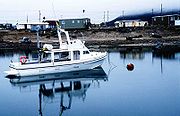
Narwhal
The narwhal, Monodon monoceros, is a medium-sized toothed whale that lives year-round in the Arctic. One of two living species of whale in the Monodontidae family, along with the beluga whale, the narwhal males are distinguished by a characteristic long, straight, helical tusk extending from their...
or walrus, is subject to international restrictions. The revenue from artistic or handicraft work, although a significant contribution to added value, provides a sufficient livelihood to only a few, particularly because of the large family sizes that must be supported. This branch of economic activity by its nature can secure the future of only a limited number. The growth of tourism is also limited. It is difficult to secure sufficient enrollment for group tours to the Arctic, and customized tours do not bring much money to the area. Cruises contribute more to added value than other types of tours.
Given all of the above, the central task of the territorial leadership is the conciliation of tradition and modern life. Whether the exemplary Nunavut model of self-determination will be successful, finally depends on the question if there will be trained Inuit in sufficient numbers in the foreseeable future who will be able to provide leadership.
The backlog of education and training is still immense. Big opportunities will open for the Inuit to maintain their traditional culture and still live up to the claim of being members of a nation that embraces diverse cultures within a modern industrial country, but only if those responsible for Nunavut succeed in training executives in sufficient numbers for the immense tasks that are the consequence of creating a self-governed territory.
Movies
- Nanook of the NorthNanook of the NorthNanook of the North is a 1922 silent documentary film by Robert J. Flaherty. In the tradition of what would later be called salvage ethnography, Flaherty captured the struggles of the Inuk Nanook and his family in the Canadian arctic...
(Robert J. FlahertyRobert J. FlahertyRobert Joseph Flaherty, F.R.G.S. was an American filmmaker who directed and produced the first commercially successful feature length documentary film, Nanook of the North...
), 1922 - EskimoEskimo (film)Eskimo was a 1933 film directed by W.S. Van Dyke. It was the first major studio film made in Alaska, and starred Ray Mala, a half-Inupiat actor, and was one of the first dramatic films to use a nearly all-native cast. In 1934, it received the first Academy Award for Best Film Editing, awarded to...
(Peter FreuchenPeter FreuchenPeter Freuchen, born Lorenz Peter Elfred Freuchen was a Danish explorer, author, journalist and anthropologist.-Biography:...
, W. S. „Woody“ Van Dyke IIW. S. Van DykeWoodbridge Strong "Woody" Van Dyke, Jr. was an American motion picture director.-Early life and career:...
), 1932–33 - Trial at Fortitude BayTrial at Fortitude BayTrial at Fortitude Bay is a TV movie released in 1994 and directed by Victor Sarin. It stars Henry Czerny, Raoul Trujillo, and Lolita Davidovich. Davidovitch plays Giana Antonelli, an attorney assigned to defend an Inuit youth from charges of sexual assault against a minor...
(Victor SarinVic SarinVic Sarin is an Indian-born Canadian/American film director, producer and screenwriter. His work as a cinematographer includes Partition, Margaret's Museum, Whale Music, Nowhere to Hide, Norman's Awesome Experience, and Riel. He also directed such projects as Partition, Left Behind, and Wind at My...
), 1994 - KikkikKikkikKikkik was an Inuit woman who, in 1958, was charged with but acquitted of murder, child neglect and causing the death of one of her children. Her story was told by Farley Mowat.- Relocation :...
(Martin Kreelak, Ole Gjerstad, Elisapee Karetak), 2000 - Atanarjuat – The Fast RunnerAtanarjuatAtanarjuat is a 2001 Canadian film directed by Zacharias Kunuk. It was the first feature film ever to be written, directed and acted entirely in Inuktitut...
(Zacharias KunukZacharias KunukZacharias Kunuk, is a Canadian Inuk producer and director most notable for his film Atanarjuat, the first Canadian dramatic feature film produced completely in Inuktitut...
), 2001 - MinikMinik WallaceMinik Wallace was an Inuit brought as a child in 1897 from Greenland to New York with his father and others by the explorer Robert Peary. The six Inuit were studied by staff of the American Museum of Natural History, which had custody...
(Axel Engstfeld), 2006
Literature
- Bryan & Cherry Alexander: Eskimo – Jäger des hohen Nordens. Belser, Stuttgart 1993. ISBN 3-7630-2210-4
- Kai Birket-Smith: Die Eskimos. Orell Füssli, Zürich 1948.
- Fred Bruemmer: Mein Leben mit den Inuit. Frederking & Thaler, München 1995. ISBN 3-89405-350-X
- Ernest Burch Jr., Werner FormanWerner FormanWerner Forman was a Czech photographer, especially known for his art books on Ancient civilisations and non-European cultures. He published more than 80 books with his photographic images. The texts were mostly written by specialists in the area...
: The Eskimos. University of Oklahoma Press, Norman 1988, Macdonald/Orbis, London 1988. ISBN 0-8061-2126-2 - Brian M. Fagan: Das frühe Nordamerika – Archäologie eines Kontinents. C. H. Beck, München 1993. ISBN 3-406-37245-7
- Kenn Harper, Kevin Spacey: Give Me My Father's Body. The Life of Minik, the New York Eskimo. Steerforth Press, South RoyaltonVT 2000. ISBN 1-883642-53-1
- Kenn Harper: Minik – Der Eskimo von New York. Edition Temmen, Bremen 1999. ISBN 3-86108-743-X (deutsche Ausgabe)
- Richard Harrington: The Inuit – Life as it was. Hurtig, Edmonton 1981. ISBN 0-88830-205-3
- Gerhard Hoffmann (Hrsg.): Im Schatten der Sonne – Zeitgenössische Kunst der Indianer & Eskimos in Kanada. Edition Cantz, Stuttgart 1988. ISBN 3-89322-014-3
- Betty Kobayashi Issenman: Sinews of Survival – The Living Legacy of Inuit Clothing. UCB Press, Vancouver 1997. ISBN 0-7748-0596-X
- Robert McGhee: Ancient People of the Arctic. UBC Press, Vancouver 1996. ISBN 0-7748-0553-6
- David Morrison, Georges-Hébert Germain: Eskimo – Geschichte, Kultur und Leben in der Arktis. Frederking & Thaler, München 1996. ISBN 3-89405-360-7
- Maria Tippett, Charles Gimpel: Between Two Cultures – A Photographer Among the Inuit. Viking, Toronto 1994. ISBN 0-670-85243-0
- Ansgar Walk: Im Land der Inuit – Arktisches Tagebuch. Pendragon, Bielefeld 2002. ISBN 3-934872-21-2
- Ansgar Walk: Kenojuak – Lebensgeschichte einer bedeutenden Inuit-Künstlerin. Pendragon, Bielefeld 2003. ISBN 3-934872-51-4
External links
- History of the Inuit
- Roger Uchtmann: The Story of the Extinguished Lamps – the Depolarization of a Polar Culture (German)
- Government of Greenland (Danish/Inuktitut)
- Government Nunavut (English/Inuktitut)
- Government of Kativik, Québec (English/French/Inuktitut)
- Inuit culture – abridged history; Inuit way of living past and present in comparison (German)
- The McDougall Sound Archaeological Research Project

